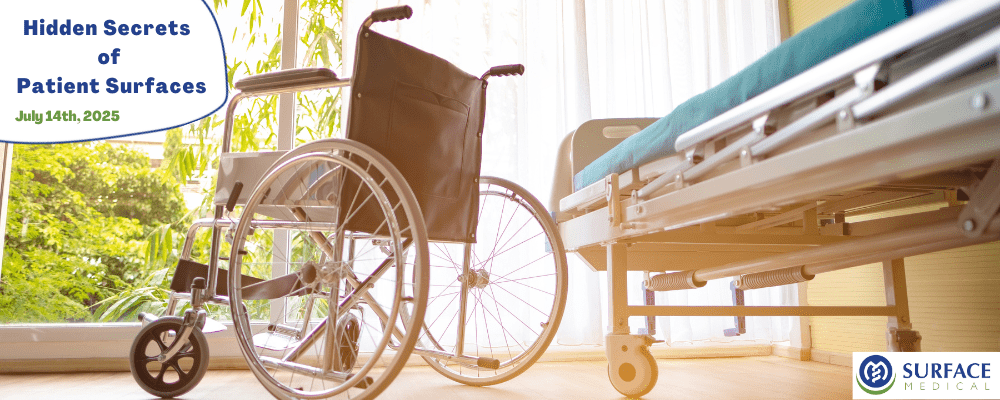Damaged surfaces – a surprisingly common yet little-known problem.
A new study conducted in the United States found that 59% of surfaces in the healthcare setting require replacement (Todd et al., 2025). This one-year study assessed more than 5,000 patient surfaces across rural, suburban, and urban healthcare facilities. It indicates that the average half-life of medical surfaces is four years, despite mattress manufacturers recommending replacement after five years (Medline, 2023). This observation reinforces the fact that surface damage is a common problem, often shortening the lifespan of valuable patient equipment.
Although conversations highlighting the prevalence of this problem are relatively new, damaged patient surfaces are a concerning problem, worthy of greater discussion. Damaged surfaces cannot be cleaned properly, and therefore pose an infection risk to both patients and staff from cross-contamination. Pathogens and other contaminants penetrate damaged patient surfaces through rips and punctures. Once a surface is damaged, it can contribute to the spread of healthcare-acquired infections (HAIs) (Todd et al., 2025). Many infection prevention protocols dictate that medical surfaces remain intact and cleanable, and damaged surfaces must be replaced immediately. However, the study shows that, in practice, many compromised surfaces remain in use, with damage often going undetected.
The study done by Todd and colleagues emphasizes the importance of implementing a robust medical surface maintenance and inspection program. Other studies have yielded similar results, and a 2018 study demonstrated a damage rate of 32.5% when more than 2,500 hospital mattresses were assessed (Marks et al., 2018). If healthcare facilities prioritize prevention and early detection, many of these surfaces can be safely repaired at a fraction of the cost of replacement.
CleanPatch is an FDA-registered repair patch that repairs tears, punctures, delamination, and other damage. CleanPatch returns the surface to a fully intact and cleanable state, minimizing the risk of HAIs and preventing the premature replacement of valuable equipment.
A 2018 study demonstrated the repairability of damaged medical surfaces (Marks et al., 2018). It was found that 55.6% of damaged surfaces could be repaired, diverting 463 mattresses from premature disposal in a landfill. Damage generally starts small, but if left undetected, it will increase until the only solution is replacement.
“But how do you implement a comprehensive maintenance and inspection program?”
A key consideration when starting a surface maintenance program is the investment of time and energy. While inspection and maintenance may seem like a hassle, replacement and procurement processes are far more costly and lengthy. Fortunately, the infrastructure for a maintenance and inspection program is often already in place. For example, routine room turnover provides an opportunity for EVS staff (environmental services) to perform a visual inspection of equipment, such as hospital mattresses, stretchers, and wheelchairs. Similarly, Biomedical Technicians can inspect equipment while performing routine services and can identify and report damage quickly.
CleanPatch enables repair at the point of detection, allowing almost any healthcare professional to identify and repair damage immediately. Some facilities may choose to stock CleanPatch products in EVS carts, at nursing stations, or in other accessible locations, further streamlining staff’s ability to repair damage and minimize equipment downtime.
With minimal effort, healthcare facilities can safely extend the life of medical surfaces. Prioritizing the integrity of medical surfaces protects patients and staff, and it contributes to sustainable practices. Surface damage is a prevalent problem, but it does not have to be. To learn more about how you can get the most out of your patient surfaces, please contact Surface Medical at info@surfacemedical.ca.
As an example, the video below demonstrates how EVS professionals can help implement surface repair in routine practice:
References
Marks, B., de Haas, E., Abboud, T., Lam, I., & Datta, I., (2018). Uncovering the rates of damaged patient bed and stretcher mattresses in Canadian acute care hospitals. Canadian Journal of Infection Control, 33(3), 171-175. https://cleanpatch.ca/wp-content/uploads/2020/08/Surface-Medical-Publication-in-Canadian-Journal-of-Infection-Control-Fall-2018.pdf
Medline. (2023, August). Medical mattresses: Would yours pass inspection?. News and Insights. https://www.medline.com/strategies/skin-health/medical-mattresses-inspection/
Todd, J., Manista, G., Nicholson, L., Ikpeze, T., Black, J., & Koshy, T. (2025). Assessment of Support Surface Integrity in the Acute Health Care Setting. J Wound Ostomy Continence Nurs., 52(3), 181-189. 10.1097/WON.0000000000001182


